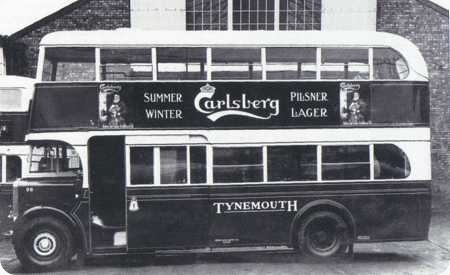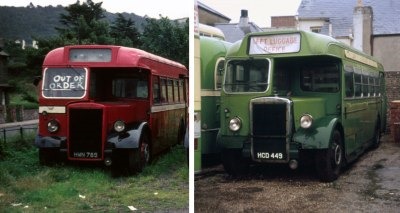Tynemouth and District – Leyland Titan TD5 – FT 4498 – 98
Tynemouth and District
1938
Leyland Titan TD5
Weymann H??F
More from my youth. 98 was one of eight 1938 forward entrance Weymann bodied Leyland TD5’s delivered to the Northern General subsidiary of Tynemouth and District. They were FT 4496/4503 numbers 96/103. About 1950 in common with many pre war vehicles they were given a new lease of life and re bodied.
100 is seen here with its second body, and you could be forgiven for asking how ECW bodies came to be in a BET fleet? Well in fact they’re Northern Coachbuilders H30/26R. I’m aware of one example of the type that’s still around, NVK 341 is a beautifully restored 1950 Newcastle Corporation AEC Regent 111 and has been featured on this site. I don’t know if the doors on the Weymann’s were powered or manual and almost certainly they would not have been equipped with heaters, but they seem to have been well ahead of their time. Does anyone know of any survivors?
Photograph and Copy contributed by Ronnie Hoye
18/12/12 – 16:35
I am not familiar with Northern General, but the forward entrance Weymann body looks very much like the ones mounted on AEC Regent chassis for Midland General in the late 30s. I can remember travelling on one of these about 1953 on the C5 Alfreton to Nottingham route. I don’t think the sliding doors were powered. Trent also had some similar ones, but these were rebodied with conventional rear entrance Willowbrook bodies (lowbridge from memory) around 1950 I think. It’s remarkable to that immediately before WW2 Nottingham had three different operators with forward entrance double deckers – since Barton also had quite a lot of Leylands, some of them rebodies of older vehicles bought second hand. These were not Weymanns however.
Stephen Ford
19/12/12 – 07:32
I’m very pleased you mentioned those Stephen because one thing I noticed was that although the Trent and Midland General Regents both dated from 1937 and both were bodied by Weymann, they were somewhat different. The MGO bodies were basically same as the Tynemouth example above. The Trent examples had an odd, longer length second window bay which resulted in a much shorter rearmost side window on both decks. Also, the bulkhead under the canopy had a single window on the MGO vehicles whereas on the Trent ones, there were twin windows. So, it would seem that Weymann had more than one front entrance double deck design in production at the same time. It makes you wonder why certain operators preferred such subtle differences.
Chris Barker
19/12/12 – 07:32
Some very nice views there, Ronnie!
Pete Davies
19/12/12 – 08:45
Weymann were renown for their metal framed bodywork and classic designs. Pre-war, there were three separate products – Flexible, Coachbuilt and Metal. Coachbuilt approximated to the composite framework used by Charles H Roe up to 1968. The featured body is a composite body. Mansfield District/Midland General had both composite and metal bodies in the pre-war period.
David Oldfield
19/12/12 – 13:39
The first photograph – that’s an original, right ?
After classic coaches, the second love of my life is the amber nectar….I’m not a historian, but genuinely amazed that Carlsberg existed all those years ago and, even more amazement, they hoped to sell it in the North East in competition with Newcastle Brown !!
Stuart C
20/12/12 – 08:05
Stuart, according to the encyclopaedia website, that brewing company was founded in 1847, and now controls a fair number of brands. The list might make you weep into your drink but includes Tetley and Scottish & Newcastle . . .
Pete Davies
20/12/12 – 09:39
An equally surprising ‘brewing’ fact is that lager, per se, was so popular in an era when most folk seemed to drink ale, porter or mild and bitter. I’ve seen pre- 1914 adverts on trams for Tuborg lager and one, dated 1908, for ‘Alsopp’s British Lager’ To me, lager seemed to take off in the late 1950’s.
Chris Hebbron
20/12/12 – 09:43
Presumably you stuck your Carlsberg on a boat and just headed west. Do you notice that they were anxious to explain that Lager (or Pilsner if you not sure what to call the stuff although it was always a long way from Pilsn) was not just a cold summer drink…? They succeeded!
Joe
21/12/12 – 07:27
Unusual to see a bus that looked so good in both incarnations, though for sheer character I go for the front-entrance original. The nice lining-out and dignified fleet name are a fine finishing touch. Did Northern Coachbuilders build these ECW lookalikes on licence, or to order, or simply as the sincerest form of flattery? Their own designs always look very good to my eye as well.
Ian Thompson
21/12/12 – 10:40
Ian. An ECW man was enticed to NCB just before NCB’s major shareholder died and they were landed with crippling death duties which did for the company. This body is closer to ECW’s original than the Newcastle Regent III – which has slightly odd (uneven) bay spacing.
David Oldfield
22/12/12 – 14:55
I can remember seeing these front entrance double deckers on the Blyth – North Shields Ferry service 7 as a small boy around 1949-50 an once did a return trip on one accompanied by my aunt. These were very different to the usual AEC Regents allocated to this route.
Gerald Walker
07/11/14 – 06:19
I have enjoyed looking at the old photos I worked at Percy Main from 1963 until 1969 but I can not remember Ronnie Hoye but you sure know your buses.
Ray 33323
07/11/14 – 15:39
Ray, do you have a Brother called Brian, who was a fitter at Percy Main?
Ronnie Hoye
14/10/20 – 07:04
Regarding Ronnie Hoye’s observation on the re-bodying of Leyland TD5’s, I think he is wrong on this occasion. According to lthlibrary.org.uk they were given ECW bodies well before NCB came out with the new 8ft wide design in 1949/50. Below is the text pasted from the LTHL site.
"1938 Leyland TD5 No. 96 (FT4496) with original Weymann 55-seat forward entrance bodywork. It was re-bodied in 1948 by ECW with a 53-seat rear entrance body. (LTHL collection)."
Ray Jackson
16/10/20 – 06:10
Ray, I believe you are correct, In the Venture book about Northern Coachbuilders there is a photograph of one of these rebodies, that of FT 4500, complete with ECW makers label in the destination box. The photo is included to afford a comparison between the two products, ECW and NCB but it provides conclusive proof that the Tynemouth AECs were indeed bodied by ECW.
Chris Barker
17/10/20 – 06:19
That these vehicles were rebodied by ECW is confirmed by PSV Circle publications, which give the body numbers as ECW Series 2 nos. 2973-2980 (not in order) with 2973-6 being new in 10/48 and 2977-80 new in 12/48. However, there seems to be a doubt as to their seating. Fleet History PA6, which covers Tynemouth and District gives the seating split as L27/26R, although that is clearly wrong, as these were highbridge bodies, while Body List B1205 states that they were H30/26R, which was standard for this style of body. As the body list is a much more recent publication, it is, perhaps, more likely to be correct.
John Gibson
17/10/20 – 06:23
Before giving the wrong answer, Ronnie invited the question as to what ECW bodies were doing in a BET fleet, and that still stands. The answer is that the rebodying was completed by the end of 1948, and therefore would have been ordered long before ECW sales were restricted. Other non-Tilling operators for whom ECW were building at the time were Middlesbrough Corporation, Birch Bros and the Red & White group.
Peter Williamson
19/10/20 – 06:10
Following up Peter Williamson’s comment about ECW bodies supplied to non-Tilling companies, a quick trawl of "Bus lists on the Web" also shows substantial numbers of rebodying work on TD chassis for East Kent and Ribble, while Southdown took a batch of 25 PS1s with C31F bodywork, and Western Welsh took 62 PS1 with B35R bodywork, all in 1947. 4 similar buses went to Isle of Man Road Services in 1948. Southdown 1249 is seen at Bognor Depot in 1972 after conversion to a mobile left luggage office; IOMRS 57 in withdrawn condition at Ramsey in 1968.
Alan Murray-Rust
20/10/20 – 06:28
Not forgetting the batch of ECW bodied Leyland PD1s delivered to North Western in 1948 which were, in effect, lowbridge versions of the Tynemouth re-bodies, seen above.
Chris Barker
27/10/20 – 05:46
North Western was a rather different case, having been a Tilling company until 1942 and having not yet been forced to change its vehicle policy. Like some other Tilling companies, at that stage it only bought PD1s because Bristol could not build enough Ks to meet the demand.
Peter Williamson
29/10/20 – 06:15
A further comment on these rebodies, I recall them being used on service 5 between Newcastle and Whitley Bay (Cemetery). Tynemouth seemed to allocate batches of vehicles to specific routes. Another batch of vehicles were AEC Regents with NCB bodies of the earlier pre-ECW look-a-like design, these being used on service 7 between North Shields Ferry and Blyth, while my earliest memory of service 4 (Whitley Bay to Gateshead) was of the Pickering bodied Guys. That route, which was later renumbered 1 seemed to be allocated batches of new vehicles displacing earlier vehicles to other routes. I have a vague recollection that the1955 batch of Weymann Orion bodied Guys were initially used on the 1/4 before ending up on the 5 replacing the TD5s, not as far as I was concerned a change for the better.
John Gibson
01/11/20 – 06:03
John, the Weymann Orion bodied GUY Arabs (two batches of them) were sturdy and robust, typical of GUY’s.
That said, the bodies were rubbish, and soon gained the nickname of Rattletraps.
Ronnie Hoye
Quick links to the - Comments Page - Contact Page - Home Page
Comments - Please note: The comments facility is not currently available. Please see the home page for updates.
Please Note if you want to send a photograph with your comment please use the Contact Page by clicking here or send as an attachment via email.



